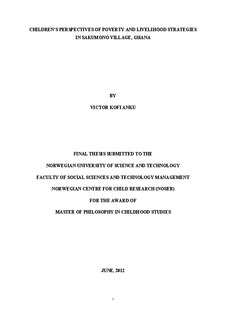| dc.description.abstract | In this study, I explored children’s perspectives and experiences of poverty and the livelihood strategies they tactically employed to fend for themselves in Sakumono Village, Ghana. I applied qualitative research method and techniques specifically; focus group discussions, unstructured interviews, drawings, photography, and ranking methods in order to gather the data for the study. This methodological approach provided an in-depth understanding of children’s perspectives and experiences of poverty and livelihood strategies and thereby highlighting the essence of social studies of childhood, which is about the live experiences of children. As such, I applied three major theoretical frameworks namely; the social studies of childhood, the intergenerational transmission of poverty and the life-course transmissions of poverty. The purpose of using these theoretical perspectives is to highlight the importance of children’s agency in the course of their lives and to shed light on how children are affected by poverty as a result of being born into poor families and how its effect move from generations to generations. The study has found out that children have different explanations and understanding of poverty. These multiple understandings depend on the individual circumstances of the child in question setting a departure from the usual understanding of poverty in seemingly monetary term. The study has also shown that there are gender faces of poverty with regard to how poverty affects both boys and girls similarly and differently. This knowledge reveals that in tackling child poverty, gender of the beneficiaries ought to be taken into consideration in order to make a meaningful impact in the lives of poor children. Furthermore, the study has revealed that children’s experiences of poverty are connected to the kind of employment their parents or caregivers are engaged in, and the number of siblings that the child has in his or her family as these have to do with the availability of resources at home. The study revealed how children engage in different livelihood strategies as ways of fighting poverty in their lives when family and the government fail to come to their aid, exhibiting their sense of responsibility, agency, entrepreneurship, and contributions to their families. Having considered children’s perspectives and experiences of poverty and the livelihood strategies, it is recommended that policies that aim to tackle child poverty should consider the opinions and voices of poor children as well as their family backgrounds. It was also suggested that, in assessing the needs and problems of poor children, the gender faces of poverty and individual circumstances of the children have to be taken into consideration in order to provide appropriate forms of interventions. | nb_NO |
